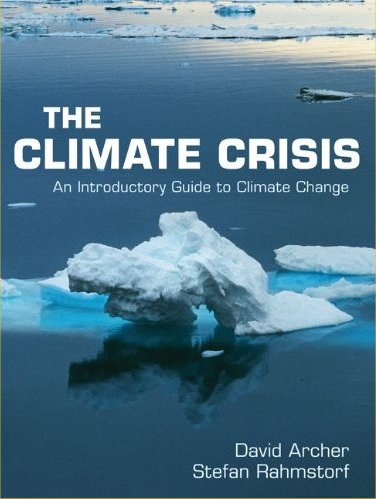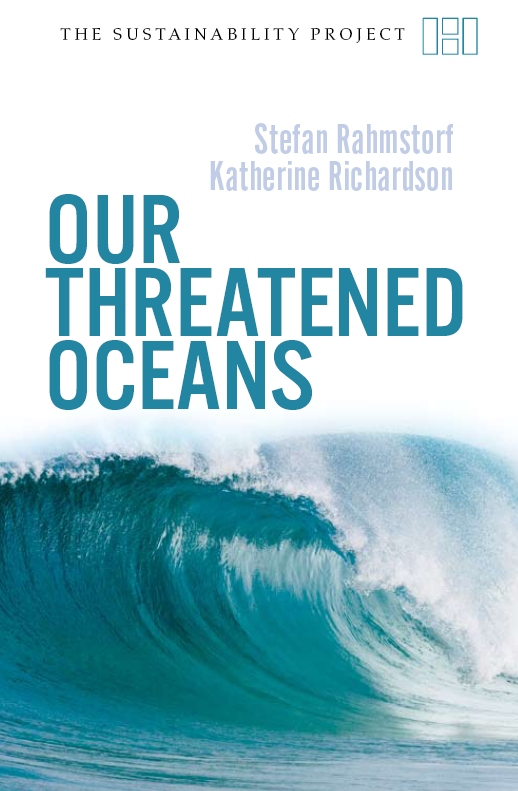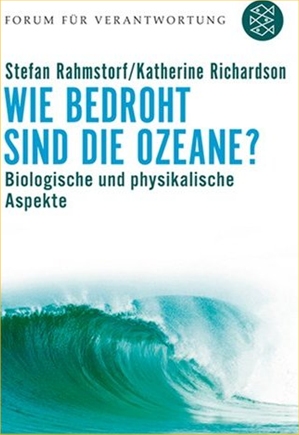ERCA Lectures 1998 (Abstracts)
- 1 - The Ocean in the Climate System: Basic Concepts
- 1.1 - Global Budgets
- 1.2 - Surface Exchange
- 1.3 - Oceanic Mixed Layer and Convection>
- 1.4 - Large Scale Transport
- 1.5 - References
- 2 - Ocean Circulation: Mode Changes and Abrupt Climate Change
- 2.1 - Positive Feedback and Multiple Equilibria
- 2.2 - Advective Spindown
- 2.3 - Convective Instability
- 2.4 - Ocean Circulation and Climate of the Last Glacial
- 2.5 - References
- 3 - Ocean Circulation: Decadal and Centennial Variability
- 3.1 - Basic Mechanisms of Circulation Variability
- 3.2 - Circulation Variability in Models>
- 3.3 - References
1 The Ocean in the Climate System: Basic Concepts
The ocean plays its important role in the climate system in many different ways:- It covers 71% of the Earth's surface
- It absorbs and reflects solar radiation (albedo)
- It stores heat (heat capacity, latent heat)
- It transports heat (climate variability)
- It is a source of water vapour (greenhouse effect, precipitation)
1.1 Global Budgets
We will begin our survey by a look at the global budgets of heat, freshwater and carbon dioxide. The mean temperature of the planet depends on its albedo; satellite measurements show that the planetary albedo is 0.31. Open ocean water has a very small albedo of 0.1-0.2, i.e. the ocean absorbs 80-90% of the incoming radiation. On the other hand, the albedo of ice-covered ocean ranges from about 0.3-0.7. Therefore, the distribution of oceans and their ice coverage has a major influence on the radiation budget of our Earth. The Earth receives far more solar heating in the tropics than near the poles, and the ocean circulation works together with the atmosphere to transport excess heat towards high latitudes.The ocean also is the major source of water vapour; around 1.2 m of water evaporates from the surface each year, that is 440,000 km3 of water.
Likewise, the world ocean is the
largest carbon store in the global carbon cycle. It has so far absorbed
about a third of all the excess carbon dioxide emitted by human activity.
1.2 Surface Exchange
The exchange of heat, water and gases between ocean and atmosphere locally depends on the air-sea difference of the property (e.g. air-sea temperature difference for heat) and can be calculated from bulk formulae, which also use information on wind speed and stability of the atmospheric boundary layer. We will discuss maps of air-sea fluxes of sensible and latent heat. It is important to distinguish the local sensitivity of the heat flux to sea surface temperature (i.e. for a given air temperature) from the sensitivity of the coupled system to large scale ocean changes (i.e. including the atmospheric response).The presence of sea ice strongly
reduces air-sea exchange; this is why Polynyas play an important role for
the heat exchange in ice-covered regions of the ocean.
1.3 Oceanic Mixed Layer and Convection
The ocean's surface mixed layer acts as the prime buffer for heat storage on the seasonal time scale. We will discuss the seasonal mixed layer cycle and its role in modifying the air temperature cycle over the oceans, as can be seen for example by looking at a global map of the seasonal temperature amplitude. The depth of the mixed layer in summer is primarily determined by wind mixing, while in winter in mid and high latitudes it is set by convective mixing. High-latitude convection is also a crucial process in the formation of deep water and the thermohaline circulation.1.4 Large Scale Transport
In order to understand the large scale heat transport by the oceans and how it affects climate, we first have to discuss some basic dynamics of the wind-driven and thermohaline ocean circulations. We will look at the basic forces driving ocean currents, at the Sverdrup balance, western boundary currents, Ekman flow and theories of the deep circulation. This leads us to an overview of the general ocean circulation and to simple estimates of the ocean's heat transport.1.5 References
The following books provide a good introduction to the basic concepts discussed in the lecture:Apel, J.R. Principles of Ocean Physics. 634pp. (Academic Press, London, 1987).
Gill, A.E. Atmosphere-Ocean Dynamics. 662pp. (Academic Press, San Diego, 1982).
Houghton, J.T., et al. Climate Change 1995. The IPCC Report. 572pp. (Cambridge University Press, Cambridge, 1995).
Open University Course Team. Ocean Circulation. 238pp. (Pergamon, Oxford, 1989).
Peixoto, J.P. & Oort, A.H. Physics of Climate. 520pp. (American Institute of Physics, New York, 1992).
Stocker, T. The ocean in the climate
system: observing and modeling its variability, in: Physics and chemistry
of the atmospheres of the Earth and other objects of the solar system (ed.
Boutron, C.) pp. 39-90 (Les Editions de Physique, Les Ulis, 1996).
2 Ocean Circulation: Mode Changes and Abrupt Climate Change
The ocean circulation does not just have a regulating or damping effect on climatic changes. Rather, it may well be one of the prime causes of rapid and drastic climate swings. Such abrupt changes are seen for example in the past climate records preserved in the Greenland Ice Sheet and in oceanic sediments. The reason why the ocean is a prime suspect for some of the erratic behaviour of the climate system lies in the peculiar stability properties of the thermohaline ocean circulation, which will be discussed in this lecture. Review articles on thermohaline circulation stability are Weaver and Hughes (1992), and Rahmstorf, Marotzke, and Willebrand (1996).2.1 Positive Feedback and Multiple Equilibria
The main reason for the non-linear behaviour of the ocean circulation is the existence of positive feedback mechanisms. We know of at least two major positive feedbacks which affect the large-scale thermohaline circulation: an advective and a convective feedback.- The advective feedback: the thermohaline circulation advects salty water northward in the Atlantic, this enhances salinity and density in the north, which in turn keeps the thermohaline circulation going (Stommel 1961; Bryan 1986).
- The convective feedback: convective vertical mixing continually removes freshwater from the surface in areas of net precipitation; it thus prevents the formation of a fresh light surface layer which could stop convection (Welander 1982; Lenderink and Haarsma 1994).
2.2 Advective Spindown
The mode transition associated with the advective feedback is called an advective spindown. With the help of Stommel's (1961) classic box model we can construct a simple stability diagram of the thermohaline circulation. This shows that the circulation has a saddle-node bifurcation, i.e. a critical threshold of how much freshwater input the circulation can sustain. When this threshold is exceeded, an advective spindown of the circulation occurs on a time-scale of centuries. This stability behaviour can be reproduced with state-of-the-art general circulation models (Rahmstorf 1995; Rahmstorf 1996). An advective spindown of the Atlantic thermohaline circulation has been forecast for the next centuries due to man-made global warming (Manabe and Stouffer 1993; Stocker and Schmittner 1997).2.3 Convective Instability
The mode transition associated with the convective feedback is called a convective instability. In contrast to the advective spindown this is a very fast process, leading to circulation changes on a time scale of a decade or so. This is the mechanism that could explain some of the abrupt climate changes seen in the ice core record, e.g. the Younger Dryas event. There are two types of convective instability: a basin-wide ('polar halocline catastrophe') and a local one. A basin-wide convective instability interrupts all deep water formation in the ocean basin and leads to a rapid collapse of the thermohaline circulation. A localised convective instability shuts down convection just in one area and leads to a rearrangement of convection patterns without shutting down the large-scale circulation; for example, it can cause a shift of convection from the Greenland Sea to a different location south of Iceland. Although not as drastic as a complete shutdown of the circulation, shifts in convection pattern can also have a major effect on climate (Rahmstorf 1994).It should be noted that all the
circulation changes discussed could also occur simply as a passive response
of the ocean to changes in the forcing, but the positive oceanic feedbacks
involved make the response highly non-linear and can strongly amplify the
reaction of the climate system to fairly gradual and subtle forcing changes.
2.4 Ocean Circulation and Climate of the Last Glacial
Recently it has become possible to simulate the climate and atmospheric and oceanic circulations of the last glacial maximum (LGM) with a computer model (Ganopolski et al. 1998). The results of this simulation will be discussed; they suggest that ocean circulation changes have amplified Northern Hemisphere cooling during the LGM by about 50%.2.5 References
Bryan, F., 1986: High-latitude salinity and interhemispheric thermohaline circulation. Nature, 323, 301-304.Ganopolski, A., S. Rahmstorf, V. Petoukhov and M. Claussen, 1998: Simulation of modern and glacial climates with a coupled global climate model. Nature, accepted.
Lenderink, G. and R. J. Haarsma, 1994: Variability and multiple equilibria of the thermohaline circulation, associated with deep water formation. J. Phys. Oceanogr., 24, 1480-1493.
Manabe, S. and R. J. Stouffer, 1993: Century-scale effects of increased atmospheric CO2 on the ocean-atmosphere system. Nature, 364, 215-218.
Rahmstorf, S., 1994: Rapid climate transitions in a coupled ocean-atmosphere model. Nature, 372, 82-85.
Rahmstorf, S., 1995: Bifurcations of the Atlantic thermohaline circulation in response to changes in the hydrological cycle. Nature, 378, 145-149.
Rahmstorf, S., 1996: On the freshwater forcing and transport of the Atlantic thermohaline circulation. Clim. Dyn., 12, 799-811.
Rahmstorf, S., J. Marotzke and J. Willebrand, 1996: Stability of the thermohaline circulation. In The warm water sphere of the North Atlantic ocean, edited by W. Krauss, Borntraeger, Stuttgart, pp. 129-158.
Stocker, T. and A. Schmittner, 1997: Influence of CO2 emission rates on the stability of the thermohaline circulation. Nature, 388, 862-865.
Stommel, H., 1961: Thermohaline convection with two stable regimes of flow. Tellus, 13, 224-230.
Weaver, A. J. and T. M. C. Hughes, 1992: Stability and variability of the thermohaline circulation and its link to climate. In Trends in physical oceanography, Trivandrum, India, pp. 15-70.
Welander, P., 1982: A simple heat-salt
oscillator. Dyn. Atmos. Oceans, 6, 233-242.
3 Ocean Circulation: Decadal and Centennial Variability
Apart from the mode changes, which can be seen as one-off 'events', the thermohaline ocean circulation can also sustain more or less regular oscillations on decadal and centennial time scales (and possibly even longer). Observational evidence for decadal variability of the thermohaline circulation is mostly indirect, in form of observed changes in the temperature and salinity structure of the deep ocean. Hydrographic data from different periods of the past decades have been compared, using either comprehensive data compilations (Levitus and Antonov 1995) or individual repeated sections (Bryden et al. 1996), revealing substantial interdecadal variation. Very recently, Bacon (1997) has compiled hydrographic sections off Greenland and has concluded that there is good evidence for decadal variations in overflow from the Nordic Seas. He linked these overflow changes to the North Atlantic Oscillation (NAO) index. Strong variability is also found in the Labrador Sea convection. Regular observations from Ocean Weather Station Bravo (Lazier 1980) show that deep convection occurred almost every winter until 1967, but then stopped for several years until convective activity resumed in 1972. The interruption of convection was a consequence of the so-called Great Salinity Anomaly (Dickson et al. 1988). The Greenland ice cores also show decadal and centennial climate variability during the Holocene which could be linked to ocean circulation variability.3.1 Basic Mechanisms of Circulation Variability
One may group the mechanisms for ocean circulation variability into the following five categories:- Hasselmann's mechanism: integration of white noise forcing. In this mechanism the ocean plays but a passive role, integrating the effect of weather fluctuations in the overlying atmosphere, which essentially acts like a random forcing on the ocean.
- Stochastic excitation of damped oceanic internal modes. Simple conceptual models can be used to demonstrate how thermohaline feedbacks can lead to internal oscillations. An instructive "gallery" of oscillators was presented by Welander (1986). Some of these oscillations are damped and would die out if not excited by some forcing.
- Self-sustained internal oscillations. These modes are related to the previous category, but are self-sustaining due to non-linear feedback, so that they don't need to be excited by forcing. A prototype of advective oscillations is the Howard-Malkus loop oscillator (Welander 1967), where flow in a differentially heated ring of fluid is driven by temperature differences.
- Externally forced variability. This category covers decadal variability which has its cause outside the oceans, e.g. variability in freshwater runoff which affects the thermohaline circulation.
- Coupled modes. There is no universally agreed definition of what constitutes a coupled ocean-atmosphere mode. We will define it as follows: coupled modes require a non-local feedback between ocean and atmosphere to generate variability, i.e. more than a simple local damping of anomalies. The classic example of a coupled mode is El Niño/Southern Oscillation, where changes in atmospheric winds trigger a dynamical response of the oceanic mixed layer and equatorial waves, which ultimately lead to a delayed negative feedback on the initial anomaly (Cane 1992). To what extent decadal variability in the North Atlantic is a coupled mode is currently an important research topic.
3.2 Circulation Variability in Models
Many ocean circulation and coupled climate models show decadal or centennial variability of the ocean circulation (e.g. Delworth, Manabe, and Stouffer 1993). Some examples of recent model experiments will be discussed during the lecture.3.3 References
Bacon, S., 1997: Evidence for decadal variability in the outflow from the Nordic Seas. , submitted.Bryden, H. L., M. J. Griffiths, A. M. Lavin, R. C. Millard, G. Parilla and W. M. Smethie, 1996: Decadal changes in water mass characteristics at 24 N in the subtropical North Atlantic ocean. J. Clim., 9, 3162-3186.
Cane, M. A., 1992: Tropical Pacific ENSO models: ENSO as a mode of the coupled system. In Climate system modeling, edited by K. E. Trenberth, Cambridge University Press, Cambridge, pp. 583-614.
Delworth, T., S. Manabe and R. J. Stouffer, 1993: Interdecadal variations of the thermohaline circulation in a coupled ocean-atmosphere model. J. Clim., 6, 1993-2011.
Dickson, R. R., J. Meincke, S. A. Malmberg and A. J. Lee, 1988: The "Great Salinity Anomaly" in the northern North Atlantic, 1968-82. Progr. Oceanogr., 20, 103-151.
Lazier, J. R. N., 1980: Oceanographic conditions at Ocean Weather Ship Bravo, 1964-74. Atmos.-Ocean, 18, 227-238.
Levitus, S. and J. Antonov, 1995: Observational evidence of interannual to decadal-scale variability of the subsurface temperature-salinity structure of the World Ocean. Clim. Change, 31, 495-514.
Welander, P., 1967: On the oscillatory instability of a differentially heated fluid loop. J. Fluid Mech., 29, 17-30.
Welander, P. and D. L. T. Anderson,
1986: Thermohaline effects in the ocean circulation and related simple
models. In Large-scale transport processes in oceans and atmosphere, edited
by J. Willebrand, Reidel, Dordrecht, pp. 163-200.













